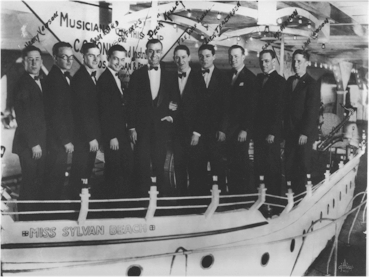
Peck Kelley band c. 1925 at Sylvan Beach, Galveston, TX. Peck is fifth from the left, Pee Wee Russell and Jack Teagarden are to the right of him. Photo: Jim Cullum collection.
The story goes that Jack Teagarden had absolutely perfect pitch and couldn’t stand to hear a piano out of tune. He carried a tuning fork with him wherever he performed, and between sets he would tune up the piano on stage so it wouldn’t drive him crazy. They say his ear was so good that at the age of five, he could call the overtones in a thunderclap. You might think these tales are a product of the boastful storytelling popular in his native state Texas, but many are verifiable. Late in life, when Jack flew in an airplane, musicians traveling with him reported he could pinpoint how many RPMs the engine made— and what key it was in.
Jack Teagarden loved machinery of all kinds—almost as much as he loved music. He’d pull apart the engine in the band bus just for the fun of it, and stay up all night putting it back together. He machined his own mouthpieces and was even a bit of an inventor.
On our radio show, Jack’s sister Norma recalls the special, high-powered fans he built for the bandstand before air conditioning, and the battery-driven headlamp Jack invented in the 40s, so he could read on the band bus at night.
Bandleader Jim Cullum tells this anecdote he heard from his father, Jim Cullum, Sr. about Jack Teagarden:
“My father played saxophone and clarinet with Teagarden’s band for awhile and told me Jack invented this special trunk to carry his horn, his music and his mutes; and it was designed to double as his music stand on stage. Jack had it rigged out as a suitcase too, for his shirts and his suits, and his toiletries and his shoes. He’d unfold this chest and set it up in front of the band on stage like a podium and it would have his suits and ties all hidden behind a panel.”
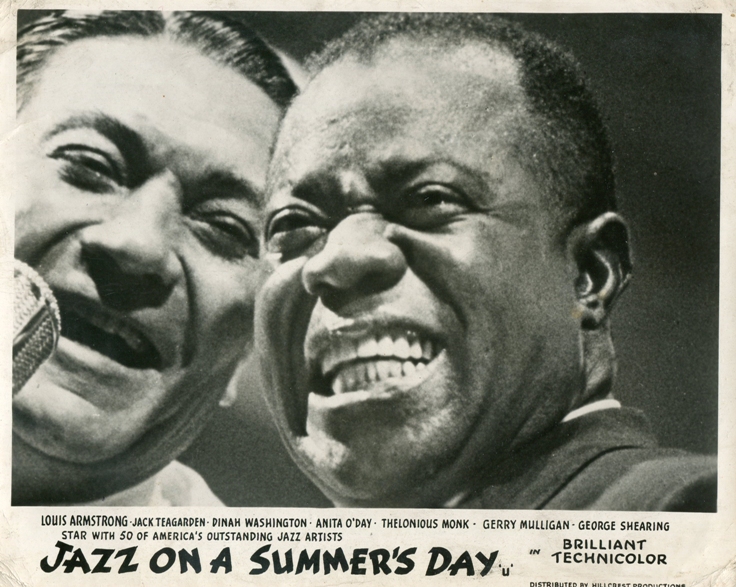
Promotional still shot from the film Jazz On A Summer’s Day. Armstrong and Teagarden singing “Rockin’ Chair.” From jazzonfilm.com and used by permission for educational purposes only.
There is far more to Jack Teagarden than his colorful character. Jim Cullum says, “Teagarden became the greatest of all Texas jazzmen; he revolutionized the role of trombone in jazz and is still thought of as its greatest exponent. In addition to his virtuosity, Jack brought a depth of feeling, or ‘soul’ to his playing and singing, which has seldom been equaled.”
Jazz Age bandleader Paul Whiteman once described Jack Teagarden’s playing this way, “They talk about hot jazz and cool jazz but when it comes to Jack Teagarden, there’s another phrase that fits his music—Warm Jazz. He has an emotional, and yet always controlled way of playing—full of meaning and compassion.”
Jack Teagarden was born in 1905 in Vernon, Texas—a cattle town in the Panhandle. He was christened Weldon Leo by his parents Helen and Charlie. Charlie was a mechanic whose job was trouble-shooting on cotton gins. His work kept him out on the road, but when he was home, Charlie played his cornet with his wife Helen on piano every chance he got.
Christmas Eve 1913, Helen and Charlie were trimming the Christmas tree in their home. They didn’t have money to buy an evergreen so they ‘made do’ with a coat rack! Just as they placed the presents under the makeshift tree, they looked up to see young Weldon Leo, wide-eyed at seeing his parents instead of Santa Claus. Their son was even more surprised to see what was under the tree—his first trombone. It was the start of the Teagarden Family Trio.
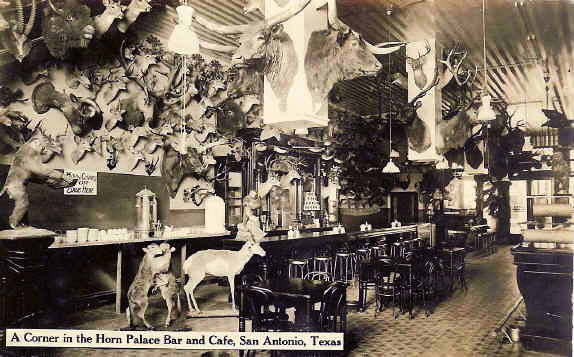
The Horn Palace. Photo courtesy of Special Collections, University of Houston Libraries.
Eight years later in 1921, Jack Teagarden turned 16 and started working as a professional musician. He came to San Antonio, joined the musician’s union and began his career at The Horn Palace; a roadhouse on the Southside. The Palace got its name from the collection of big game trophy horns decorating the walls.
Jim Cullum paints a picture of the Horn Palace as a scene out of the Wild West. Ranch hands and off-duty soldiers drank and gambled away their paychecks. Every night, there would be a fistfight. Teagarden and the rest of the band were just wide-eyed teenagers on a big adventure. One night a fight broke out and bullets started flying. Everyone took cover except Jack. By the time the fight was over, the owner of the club was dead and Jack was the District Attorney’s star witness. He was about to testify when he received threatening letters. The message was clear—“Don’t talk or you’ll sleep with the fishes.” Jack didn’t know what to do. When all seemed to be lost, San Antonio’s great flood of 1921 swept away the evidence and much of the city with it. Parts of downtown San Antonio were 15-feet underwater, including the courthouse. All the records of the Horn Palace murder were destroyed. The case was closed and Jack was off the hook.
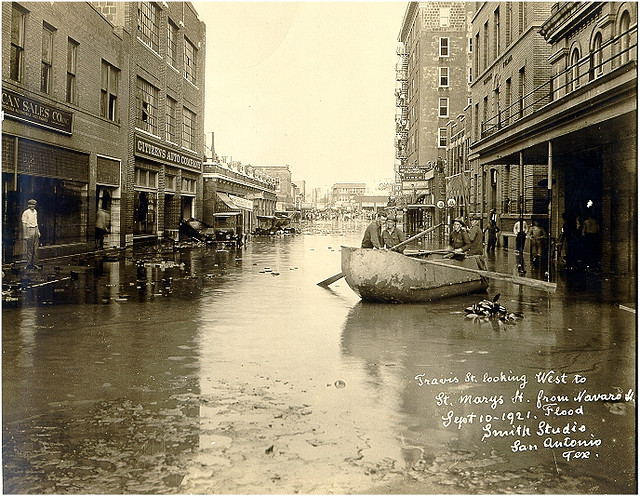
San Antonio flood of 1921. Photo in public domain.
After this experience, Jack Teagarden was anxious to get out of San Antonio. He had heard of the great jazz pianist Peck Kelley playing in nearby Houston. He packed his trombone and his clean shirts and headed out in his Stanley Steamer. He signed up with Peck’s Bad Boys, Kelley’s legendary jazz band with Pee Wee Russell on clarinet. Jack met his musical equal in Peck Kelley. He had found world-class jazz in Houston and was delighted to be at the heart of it.
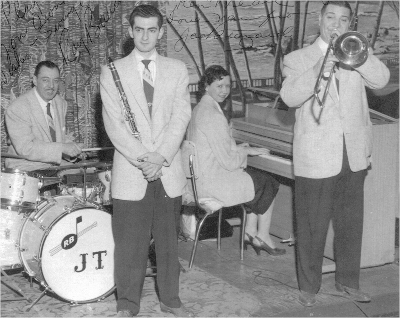
Kenny Davern, Norma Teagarden, Jack Teagarden in 1954. Photo used by permission of Elsa Davern.
In an interview on our radio show, Norma Teagarden, who played piano in her brother’s band in the 40s and 50s, had this to say about their mother, “She taught us all how to read music and started us on instruments. We all played together and never thought about doing anything else.
She went on, “Jack would have mother come on stage at the Hollywood Bowl and Monterey Jazz Festival. She would play her two piano rags and everyone would stand up and cheer! She always brought the house down. She was short and dumpy and wore those foot-saver shoes— a grey-haired little old lady, who got a standing ovation.”
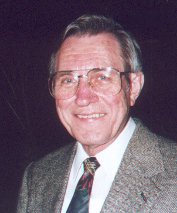
Bob Havens photo by Don Mopsick. Used by permission.
Joining us to salute Jack Teagarden is trombonist Bob Havens, best known for his 22-year stint on television with the Lawrence Welk Orchestra. Havens possesses a breathtaking and swinging command of the trombone. Bob says his playing style is a mix of influences from Jack Teagarden and East Coast Jazz Age trombonist, Miff Mole.
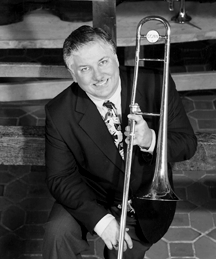
Dan Barrett photo permission of the artist.
Southern Californian Dan Barrett belongs to a younger generation of classic jazzmen born after 1950. Dan moved to New York City in 1983, where Benny Goodman heard him play at Eddie Condon’s and invited him to join what turned out to be the King of Swing’s last orchestra. Barrett was a featured soloist with the Goodman ensemble and contributed music arrangements to the band’s book. More recently, Barrett has been associated with the Arbors Jazz label and with singers Rebecca Kilgore and Daryl Sherman. Dan’s music arrangements for a Bobby Short album garnered a Grammy nomination.
John S. Wilson of The New York Times made this comment about Barrett’s playing: “(He) is one of the delights a melodist, a colorist who knows how to use a plunger mute with taste and, in total, a player Duke Ellington would have loved.”
Photo credit for Home Page teaser image: Jack Teagarden photo by Ralph F. Seghers. Used by permission of Ken Seghers.
Text based on Riverwalk Jazz script by Margaret Moos Pick ©2012

